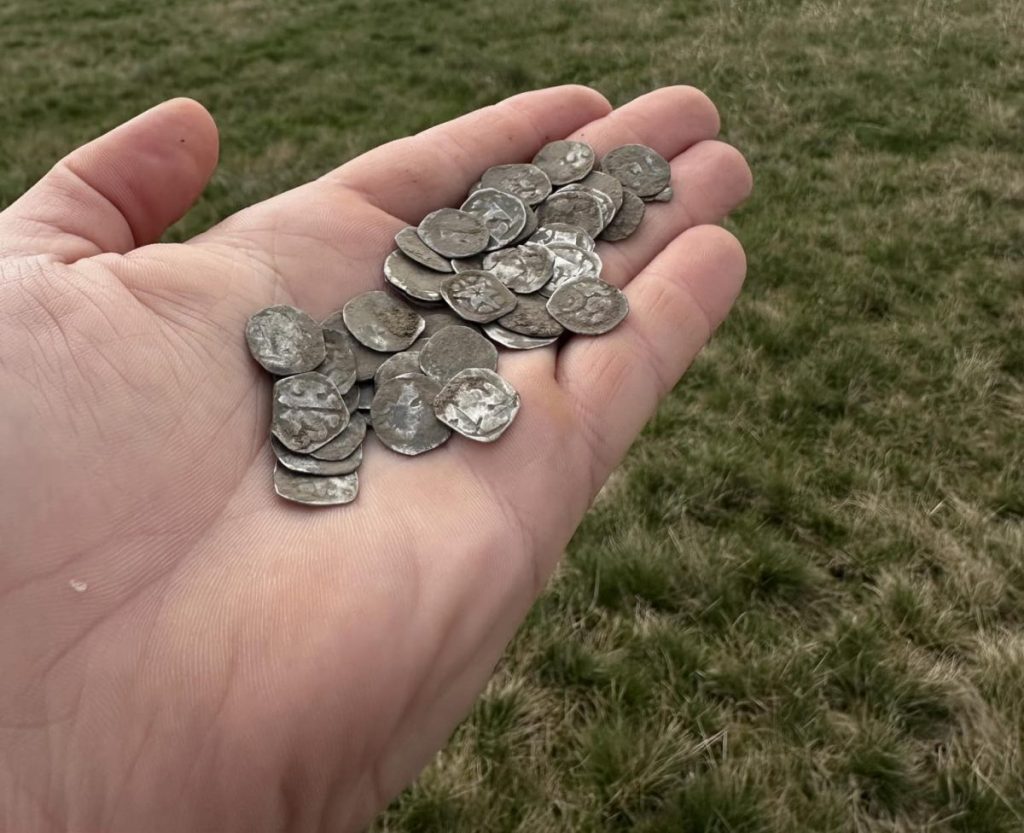A 14th-century silver communion set (chalice and wafer holder) and a treasure trove of 70 silver coins were discovered in a research project by the Hungarian National Archaeological Institute (Nemzeti Régészeti Intézet) near Lake Tisza.
The discovery was announced on the Institute’s Facebook page. In 2023, experts from the National Archaeological Institute of the Public Collection Centre of the Hungarian National Museum discovered the remains of a medieval Benedictine abbey founded by a clan during their microregional research near Lake Tisza, a unique cultural heritage.
The main purpose of the ten-year research plan of the National Archaeological Institute is to identify all the sites in the country within the framework of the “Archaeological Topography Programme”. To this end, micro-regional pilot projects have been launched, one of which can also provide the basis for developing tourism in the southeastern region of Lake Tisza based on its historical and cultural heritage.
In October 2023, in the village of Tomajmonostora, the remains of the former Benedictine abbey church were revealed during a trial excavation of the archaeological work carried out by archaeologists on the site of the former monastery.
 Photo: Hungarian National Archaeological Institute (Nemzeti Régészeti Intézet)
Photo: Hungarian National Archaeological Institute (Nemzeti Régészeti Intézet)
“Last year the layers of the three-nave monastic basilica and the early round church were also clarified. So we have found the medieval Benedictine abbey and the church of the settlement that preceded it,” he said. Excavation leader Gábor Virágos, archaeologist, deputy director general of the Public Collection Centre of the Hungarian National Museum, and president of the National Archaeological Institute.
A special discovery made during this year’s excavation was a communion set that was in the deceased person’s hand at the time of burial. The ceremonial vessels are thought to be from the 13th or 14th century and include a wafer holder and a silver chalice. They were put into the hands of a deceased individual. Although more excavation is required to determine the precise findings, it is most likely a burial component.
The micro-regional research, including the excavation at Tomajmonostora, also produced other outstanding results. The National Archaeological Institute of the Public Collections Centre of the Hungarian National Museum also pays special attention to the sites of key, fate-transforming events in Hungarian history.
 Photo: Hungarian National Archaeological Institute (Nemzeti Régészeti Intézet)
Photo: Hungarian National Archaeological Institute (Nemzeti Régészeti Intézet)
One of the milestones of this work is the identification of key sites of the battle of 1596 near Mezőkeresztes, and the collection and interpretation of artefactual material related to the battle. Here, archaeologists have found a treasure trove of 70 silver coins of the Viennese penny (denar). The hidden treasure, dating back to the 13th-14th centuries, was uncovered during a search by volunteers from the Community Archaeology Programme, led by archaeologist Gábor Bakos.
The Viennese denarii that make up the treasure were issued by the Austrian princes, contrary to their common summary name, not only from the Viennese mints but also from the Enns and Bécsujhely mints. Due to the intensive trade relations, their traffic also extended to the territory of the Kingdom of Hungary in the 1200s and 1300s.
 Photo: Hungarian National Archaeological Institute (Nemzeti Régészeti Intézet)
Photo: Hungarian National Archaeological Institute (Nemzeti Régészeti Intézet)
“Their presence is attested by the presence of coins such as the one just discovered, mainly from the western part of the country and along the trade route through Kassia to Cracow. The latter includes the medal material found in the Mezőkeresztes area,” said Enikő Kovács, numismatist and research associate.
Research continues with the participation of volunteers and local people.
Cover Photo: Hungarian National Archaeological Institute (Nemzeti Régészeti Intézet)
